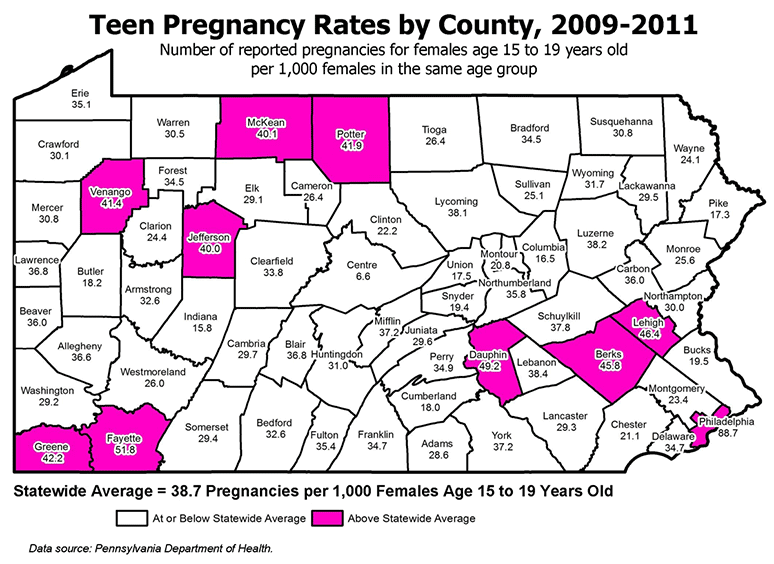
Pennsylvania’s Teen Pregnancy Rates: A Complex Issue with Multifaceted Causes
Introduction
Teen pregnancy remains a significant public health concern in the United States, with Pennsylvania facing a particularly high prevalence. According to the Centers for Disease Control and Prevention (CDC), Pennsylvania’s teen pregnancy rate in 2020 was 18.9 births per 1,000 females aged 15-19, higher than the national average of 17.4. This rate has remained relatively stable in recent years, highlighting the need for sustained efforts to address the underlying factors contributing to this issue.
Causes of Teen Pregnancy
The causes of teen pregnancy are multifaceted and include a combination of individual, social, and economic factors.
Individual Factors:
- Lack of knowledge and access to contraception: Many teens lack comprehensive sex education and access to affordable contraception, increasing their risk of unplanned pregnancy.
- Low self-esteem and depression: Teens with low self-esteem and depression may engage in risky sexual behaviors as a form of self-medication or coping mechanism.
- Peer pressure and social norms: Teens who have friends or peers who are pregnant or have children may feel pressured to conform to social norms and engage in sexual activity.
Social Factors:
- Poverty and lack of opportunity: Teens living in poverty may have limited access to education, healthcare, and job opportunities, making them more vulnerable to teen pregnancy.
- Family instability and lack of parental support: Teens from unstable or dysfunctional families may lack the guidance and support they need to make responsible decisions about sexual activity.
- Community violence and trauma: Exposure to community violence and trauma can increase teens’ risk of engaging in risky sexual behaviors as a coping mechanism.
Economic Factors:
- Limited access to healthcare: Teens without health insurance or access to affordable healthcare may have difficulty obtaining contraception or other reproductive health services.
- Low wages and job insecurity: Teens who work low-wage jobs or face job insecurity may be more likely to engage in transactional sex or other risky behaviors that increase their risk of pregnancy.
Consequences of Teen Pregnancy
Teen pregnancy has significant consequences for both the teen mother and her child.
For the Teen Mother:
- Increased risk of health complications: Teen mothers are more likely to experience pregnancy-related complications, such as premature birth, low birth weight, and postpartum depression.
- Lower educational attainment: Teen mothers are more likely to drop out of school and have lower levels of educational attainment, limiting their future economic opportunities.
- Increased poverty: Teen mothers are more likely to live in poverty and face financial instability, which can have long-term consequences for their families.
For the Child:
- Increased risk of health problems: Children born to teen mothers are more likely to have health problems, such as low birth weight, developmental delays, and chronic diseases.
- Lower educational attainment: Children born to teen mothers are more likely to have lower educational attainment and face academic challenges.
- Increased risk of poverty: Children born to teen mothers are more likely to live in poverty and face economic hardship.
Addressing Teen Pregnancy
Addressing teen pregnancy requires a comprehensive approach that addresses both the underlying causes and the consequences.
Prevention:
- Comprehensive sex education: Providing teens with comprehensive sex education, including information on contraception, sexually transmitted infections (STIs), and healthy relationships, is essential for reducing teen pregnancy rates.
- Access to contraception: Ensuring teens have access to affordable and effective contraception is crucial for preventing unplanned pregnancy.
- Peer support and mentoring: Providing teens with peer support and mentoring programs can help them develop healthy relationships, make responsible decisions, and avoid risky behaviors.
Support:
- Prenatal care and support: Providing teen mothers with access to prenatal care, nutrition, and other support services can improve the health outcomes for both the mother and the child.
- Education and job training: Supporting teen mothers in completing their education and obtaining job training can help them achieve economic stability and improve their future prospects.
- Housing and financial assistance: Providing teen mothers with access to affordable housing and financial assistance can help them overcome the challenges of poverty and create a stable environment for their families.
Conclusion
Teen pregnancy is a complex issue with multifaceted causes and significant consequences. Addressing this issue requires a comprehensive approach that includes prevention, support, and policy changes. By investing in comprehensive sex education, ensuring access to contraception, and providing support services to teen mothers and their children, we can reduce teen pregnancy rates and improve the health and well-being of our communities.